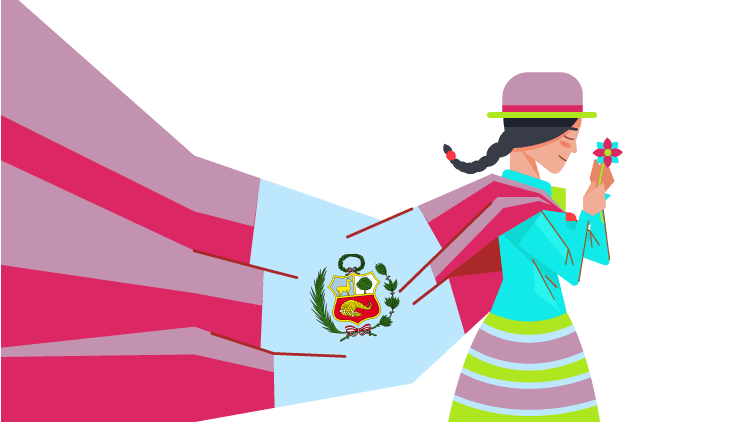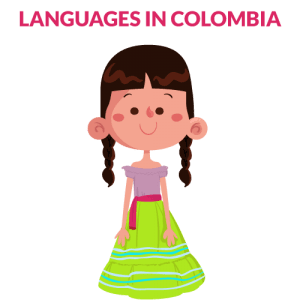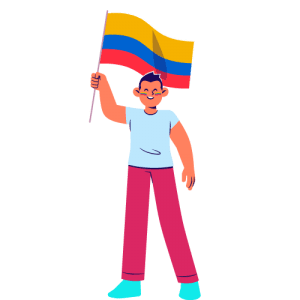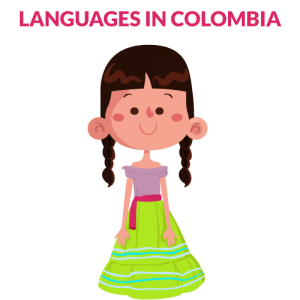
What Languages Do People Speak in Colombia?
Most people associate Colombian Spanish with the Colombian accent, but what they might not know is that the accent changes depending on where you are in the country. To better understand the beautiful variations of Colombian Spanish, it’s essential to learn basic information about the languages spoken in Colombia and how they are used. Here’s what you need to know about what languages people speak in Colombia.
Spanish Language
The official language of Colombia is Spanish. 90% of Colombians are native Spanish speakers. However, there are also many regional Spanish dialects and languages spoken around the country. The major ones include: Bolivar, Vaupés, Purépecha, Cocama-Cocamilla, Chibcha, Cofán and Guambiano.
English is not spoken anywhere near as widely as Spanish but is relatively common among students and business people. Some tourist areas will have signs written in both Spanish and English to help visitors navigate. You can use a translator to speak with people who don’t speak your language but try to learn some basic phrases first to have a better experience in Colombia.
Colombia is a South American country with additional territory with Central America. Additionally, Colombian Spanish tends to be softer and easier on American ears than Mexican or Central American Spanish. If you plan to visit Colombia for a while, it might be worth learning at least some basics of its local tongue. A few words that may come in handy include hola (hello), gracias (thank you), por favor (please), and adios (goodbye).
Historical Facts Of The Spanish Language In Colombia
The Spanish language has a long and rich history in Colombia. It is the official language of the country and is spoken by over 50 million people. There are many interesting facts about the Spanish language in Colombia, including its origins, development, and current status.
The Spanish language in Colombia had its roots in the 16th century when the country was colonized by the Spanish. Since then, it has undergone several changes, both in terms of its pronunciation and vocabulary. Today, Colombian Spanish is considered one of the purest forms of the language, thanks in part to the fact that it has been relatively isolated from other Spanish-speaking countries.

Colombian Spanish is also unique because it has been influenced by several other languages, including indigenous languages, African languages, and even English. This has resulted in several distinctive features, such as the use of the voseo verb form and various unique slang words.
Despite its long history, the Spanish language in Colombia is currently facing several challenges. The rise of English as a global language has led to a decline in the use of Spanish, particularly among younger Colombians. In addition, the country’s internal conflict has resulted in the displacement of many people, who have often had to learn new languages to survive.
The Evolution of Colombian Spanish
The Spanish spoken in Colombia has undergone several changes over the years, influenced by various factors such as geography, history, and the presence of other languages. Today, Colombian Spanish is considered a very distinctive variety of the dominant language, with its unique features. Experts estimated that only three indigenous Colombian languages were still spoken by more than 50,000 individuals at the time.
One of the most important factors influencing the development of Colombian Spanish has been geography. The country is quite large, and there are several different dialects spoken in other regions. For example, in the Andean region, the Spanish spoken is quite different from that spoken on the Caribbean coast. This is because the Andean region is more isolated, and there has been less contact with other Spanish-speaking areas. As a result, the Spanish spoken in the Andean region has retained more of its original features.
Another important factor influencing the development of Colombian Spanish has been history. For example, the Spanish spoken in Colombia today is quite different from that spoken in other parts of Latin America because of the influence of the Moorish invasion of Spain in the 8th century. This invasion led to the introduction of several Arabic words into the Spanish language, which can still be found in the Spanish spoken in Colombia today.
The presence of other popular languages in Colombia has also impacted the development of Colombian Spanish. For example, many words in Colombian Spanish have been borrowed from indigenous languages, such as Quechua and guaraní. In addition, the presence of English in the country has also led to the borrowing of several English words into Colombian Spanish.

Minority Languages Spoken In Colombia
Much of Colombia’s linguistic diversity comes from its ethnic and cultural diversity. The country is home to dozens of distinct indigenous groups, many of which have dialects.
There are at least 20 different indigenous languages spoken throughout Colombia—and some estimates place that number as high as 60 or more. As if that wasn’t impressive enough, Colombians also speak Spanish. Colombians also speak two Creole languages.
The San Andrés Creole language is spoken in the regions of Catalina, Providencia, and San Andrés. San Andrés Creole has a considerable Spanish influence, despite being related to English-based Creole languages of the Caribbean islands.
When compared to English or French (about 24 million native language speakers each), it doesn’t seem like a lot—Spanish has about 470 million native language speakers worldwide—but it puts it on par with Portuguese and Italian, two other Romance languages with a long history in their respective countries. In Colombia, Spanish is widely understood, but every region has its specific slang and grammatical quirks.
Of course, Colombia isn’t just about language; it’s also known for its incredible biodiversity and natural beauty. It’s one of only three places in South America where you can find both Andean mountain peaks and Caribbean beaches within proximity to one another.
And while Colombia may not be well-known outside of Latin America, its capital city is Bogotá, named one of the most innovative cities by Fast Company magazine in 2013. It was also ranked as one of South America’s top destinations by Travel + Leisure magazine, coming in at #4 out of 10 cities overall.
Religion in Colombia
The most spoken language of Colombia is Spanish, but there are many indigenous languages spoken by Afro-Colombians. The largest religion is Christianity, with over 90% of Colombians identifying as Roman Catholic. Protestantism and Mormonism are overgrowing, accounting for about 7% of Colombians. About 3% of Colombians follow other religions such as Judaism, Islam, and Buddhism. Muslims live primarily in urban areas like Bogotá, Medellín, and Cali.
There are also Jewish communities in Colombia’s larger cities. Colombia has one of Latin America’s smallest Buddhist populations; most Buddhists live in rural areas near Buddhist temples. In Colombia, it’s not uncommon to find people practicing Christianity and another religion at once. This is called syncretism.
Syncretic practices are common among indigenous groups throughout Colombia, including the Wayuu people on Colombia’s Caribbean coast. Many Colombian Catholics also celebrate certain indigenous rituals. For example, each year before Easter Sunday, thousands of Christians visit a statue of Jesus Christ known as El Señor de los Milagros (The Lord of Miracles) in Cartagena.
They believe that rubbing El Señor de los Milagros will bring them good luck and prosperity. On Ash Wednesday, some Colombians mix ashes from burned palm fronds into the water and drink it to commemorate Lent. Some traditional foods are served during Lent, including pan de yuca (cassava bread), arroz con coco (rice with coconut milk), and tamales.
What other languages are spoken in Colombia?
Spanish is the official language of Colombia; there are 68 Amerindian languages and dialects spoken in the country, as well as several immigrant languages. The most common Amerindian languages are Chibcha, Fuegian, Arawakan, Cariban, Tupi-Guaranian, and Quechua. English is also spoken by many Colombians, especially in the larger cities.
Does Colombia have an official language?
Spanish is the official language of Colombia. Other languages spoken in Colombia include indigenous languages, such as Quechua and Wayuu, as well as English, French, and Portuguese.
How many different native languages are spoken in Colombia?
According to Ethnologue, there are 68 different languages spoken in Colombia. The most common language spoken is Spanish, which is the official language of the country. Other languages spoken include English language, Romani language, German language, Portuguese language, Italian language, French language, and Dutch language.
Culture in Columbia
Colombians are so proud of their culture that it is inscribed on their flag: Libertadora de las Americas. Not only do Colombians speak Spanish, but they also have their version called Criollo. Criollo is a foreign language derived from Spanish, with a few indigenous words thrown in. In addition to Criollo, many people speak English due to Colombia’s proximity to other English-speaking countries like Panama and Venezuela. Other languages like German, French, and Italian are also widely spoken as many ex-pats live there.
While Colombia has a rich cultural history, its diversity means you can find almost anything you want in Colombia—even American fast-food chains! While we hope you take some time to immerse yourself in Colombian culture while visiting, you might want to learn some essential phrases before heading out. Most businesses and service providers will understand basic English, so it won’t hurt much if your Spanish isn’t up to par.
However, speaking just a little bit of Spanish can go a long way when trying to navigate tricky situations. Just remember: don’t try learning too much at once or even expect your grammar or pronunciation to be perfect – try one word at a time!

Most Popular Phrases in Colombian Spanish
Many famous phrases in Colombian Spanish are used in everyday conversation. These phrases can be used to express a variety of emotions, from happiness and excitement to sadness and anger. Some of the most popular words in Colombian Spanish include:
- “¿Qué tal?”, “¿Cómo estás?”, “Eso es una lástima”, and “No puedo creerlo”. “¿Qué tal?” is a phrase that can be used to greet someone or to ask how they are doing. It is a very friendly phrase and is commonly used among friends and family.
- “¿Cómo estás?” is another phrase that can be used to ask how someone is doing. This phrase is also very friendly and is often used in casual conversations.
- “Eso es una lástima” is a phrase used to express sadness or sympathy. It is often used when someone has just received bad news.
- “No puedo creerlo” is a phrase used to express disbelief or surprise. It can be used in various situations, from hearing about a friend’s bad day to learning about a significant world event.
In addition to these four popular phrases, many other phrases are commonly used in Colombian Spanish. For example, “¡Feliz cumpleaños!” is a phrase used to wish someone a happy birthday. “¡Buena suerte!” is a phrase used to wish someone good luck. “Te quiero” is a phrase used to express love or affection.
Learning popular phrases in Colombian Spanish is a great way to improve your communication skills and better understand the culture. By learning these phrases, you will connect more easily with native speakers and participate in everyday conversations.
Other Languages and Dialects
The major languages spoken in Colombia include Spanish and indigenous languages such as Aymara, Quechua, Nahuatl, Guaraní, and Emberá. There are eight officially recognized indigenous languages of Colombia: Arhuaco, Awá-Guajiro, Bora-Witoto, Emberá, Katio-Ewa del San Blas Kuna Yala (San Blas), Kogui-Iguanía, Kuna de Wargandí (Darien) and Tunebo.
All of these languages have their own cultural identity and native speakers. Additionally, there are nearly two dozen minority groups with their own distinct cultures that speak separate dialects. In total, Colombia has more than 70 different indigenous groups that each have their language or dialect.

In addition to Spanish and indigenous languages, Colombia is home to several other minority languages, including English, French, German and Italian. There are also several Creole languages spoken by descendants of enslaved Africans brought over by European settlers. The most common Creole language is Palenquero, which has its distinct culture and history. Many Colombians are bilingual or multilingual because they speak Spanish and one or more indigenous dialects or minority languages. Some even speak three or four different languages fluently!
English Language
The official language of Colombia is Spanish, but English is a close second. Many Colombians speak conversational English, especially younger generations and those who have lived or traveled abroad.
If you’re studying or planning to live or work in Colombia, it might be a good idea to pick up some Spanish classes before you arrive; even if most people speak basic English, it can go a long way when locals try to communicate with visitors. Also, remember that in certain parts of Colombia (mainly cities), dialects may vary from standard Spanish.
Knowing some Colombian slang words like ¿Qué onda? (what’s up?) or Aguas! (watch out!) will help you fit right in!
What other languages are spoken in Colombia?
Spanish is the official language of Colombia; there are 68 Amerindian languages and dialects spoken in the country, as well as several immigrant languages. The most common Amerindian languages are Chibcha, Fuegian, Arawakan, Cariban, Tupi-Guaranian, and Quechua. English is also spoken by many Colombians, especially in the larger cities.
Does Colombia have an official language?
Spanish is the official language of Colombia. Other languages spoken in Colombia include indigenous languages, such as Quechua and Wayuu, as well as English, French, and Portuguese.
How many different native languages are spoken in Colombia?
According to Ethnologue, there are 68 different languages spoken in Colombia. The most common language spoken is Spanish, which is the official language of the country. Other languages spoken include English language, Romani language, German language, Portuguese language, Italian language, French language, and Dutch language.
